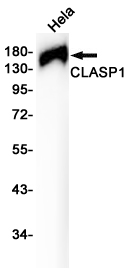
| WB | 咨询技术 | Human,Mouse,Rat |
| IF | 咨询技术 | Human,Mouse,Rat |
| IHC | 1/50-1/100 | Human,Mouse,Rat |
| ICC | 1/50-1/200 | Human,Mouse,Rat |
| FCM | 咨询技术 | Human,Mouse,Rat |
| Elisa | 咨询技术 | Human,Mouse,Rat |
| Aliases | CLASP1; KIAA0622; MAST1; CLIP-associating protein 1; Cytoplasmic linker-associated protein 1; Multiple asters homolog 1; Protein Orbit homolog 1; hOrbit1 |
| Entrez GeneID | 23332 |
| WB Predicted band size | Calculated MW: 169 kDa; Observed MW: 160 kDa |
| Host/Isotype | Rabbit IgG |
| Antibody Type | Primary antibody |
| Storage | Store at 4°C short term. Aliquot and store at -20°C long term. Avoid freeze/thaw cycles. |
| Species Reactivity | Human |
| Immunogen | A synthetic peptide of human CLASP1 |
| Formulation | Purified antibody in TBS with 0.05% sodium azide,0.05%BSA and 50% glycerol. |
+ +
以下是3篇关于CLASP1抗体的参考文献,涵盖其功能研究和应用场景:
---
1. **文献名称**: *"CLASP1 and CLASP2 bind to EB1 and regulate microtubule plus-end dynamics at the cell cortex"*
**作者**: Akhmanova A, et al.
**摘要**: 本研究利用CLASP1特异性抗体,通过免疫荧光和活细胞成像技术,揭示了CLASP1与EB1蛋白协同调控微管正端在细胞皮质区的动态稳定性,并证明其在细胞极性建立中的关键作用。
---
2. **文献名称**: *"Overexpression of CLASP1 in colon cancer associated with tumor progression and metastatic potential"*
**作者**: Mimori-Kiyosue Y, Shiomi K.
**摘要**: 通过Western blot和免疫组化分析CLASP1抗体在结直肠癌组织中的表达,发现CLASP1的高表达与肿瘤转移和患者预后不良显著相关,提示其作为癌症生物标志物的潜力。
---
3. **文献名称**: *"CLASP1 interacts with IQGAP1 and integrates microtubule and actin dynamics in migrating cells"*
**作者**: Lansbergen G, Galjart N.
**摘要**: 利用CLASP1抗体进行共免疫沉淀实验,发现CLASP1通过结合IQGAP1调控微管-肌动蛋白交联,促进细胞迁移过程中细胞骨架的动态协调,为肿瘤侵袭机制提供了新见解。
---
这些文献展示了CLASP1抗体在细胞生物学机制研究及疾病模型中的典型应用场景。如需扩展特定领域(如神经科学),可进一步补充相关研究。
CLASP1 (cytoplasmic linker-associated protein 1) is a microtubule-associated protein critical for regulating microtubule dynamics, cell polarity, and intracellular transport. It belongs to the CLASP family, which interacts with CLIPs (cytoplasmic linker proteins) to stabilize microtubules by promoting their rescue from disassembly and anchoring them to specific cellular regions, such as the cell cortex or Golgi apparatus. CLASP1 is involved in diverse cellular processes, including mitosis, cell migration, and neuronal development, by coordinating microtubule interactions with actin filaments and membrane compartments.
Antibodies targeting CLASP1 are essential tools for studying its localization, expression, and functional roles. These antibodies are typically developed in hosts like rabbits or mice using immunogens derived from specific CLASP1 domains (e.g., N-terminal or central coiled-coil regions). Validation often involves Western blotting to confirm specificity for the ~160 kDa CLASP1 protein, immunofluorescence to visualize its association with microtubule networks or Golgi structures, and immunoprecipitation to study binding partners like CLIP-170 or EB1.
Research applications of CLASP1 antibodies span neurobiology (e.g., axon guidance), cancer biology (metastasis regulation), and developmental disorders. Some antibodies distinguish CLASP1 from its paralog CLASP2. aiding isoform-specific studies. Commercial antibodies may vary in performance across species (human, mouse, rat) and require validation in knockout models or siRNA-treated cells to ensure specificity. Dysregulation of CLASP1 has been linked to neurological diseases and cancer progression, underscoring its biomedical relevance.
×